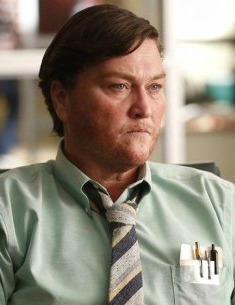TRANSTRENDING: It’s all political.
ARE YOU A WOMAN? JOKE’S ON YOU. NO YOU’RE NOT.
More stories from Holly Thompson

CHAPTER I
In which Glee sort of does something well.
6’4 and 250 pounds, self-described giant, Dot-Marie Jones has every quality of traditional masculinity, caricatured to a maximum in her role as Glee’s Shannon Beiste (“B-e-i-s-t-e. It’s French.”). Glee introduces Beiste at the beginning of its second season, a Mississippi-grown football coach recruited to lead the team to victory and refer to herself in the third person as The Panther. She wears a consistent unisex uniform of long cotton shorts + cotton polo shirt, made charming by an unusual inclusion of red lipstick and pearl earrings.
As one could expect, the addition of a female football coach sends the school into a shrieking tailspin of horror.
And so begins another instance of Glee’s favorite formula: the self-acceptance storyline. The development of Shannon Beiste, a step beyond the proverbial sensitive-woman-in-a-tough-shell, is the serious development of a new kind of archetype for women on TV. Everyone loves a SEXY WOMAN, particularly a sexy woman pistol whipping in high heels; however, real live sexy women that pistol whip in high heels are few and far between. And although there is nothing inherently wrong with these rogue ladies sprinkled across television, the population is engorged and bulging over the visibility of (at the expense of sounding trite) real women. Shannon Beiste is a tough woman, a masculine woman – thick, deep-voiced, vaguely mulleted – with a slew of insecurities to overcome. “I don’t look the way pretty girls look,” she laments to Will in “Never Been Kissed,” having just admitted that she had (as anticipated) never been kissed. Despite her appearance, Beiste isn’t gay, Beiste isn’t hardened, Beiste isn’t a beast. For the majority of her stint on the show, she wrestles with her unconventional appearance and interests, although it’s always quite clear that her ultimate desire is to be perceived as a woman.
CHAPTER 2
In which Glee nullifies its former glory.
And so, in true Glee form, Beiste had to be manipulated into a politicized plot point. There isn’t much merit to Glee nowadays – most people treat it like the joke that it is, but, somehow, when Beiste came out as transgender in the recently aired “Jagged Little Tapestry,” the world halted, tears were shed, Nobel Peace Prizes were lined up for acceptance by Ryan Murphy and Brad Falchuk. It was covered by Huffington Post, The Advocate, even the International Business Times.
Bustle described the budding transition as “powerful storyline that pushes the envelope in the way only this series can.”
That assessment is incorrect. Compared to transgender actress Laverne Cox’s portrayal of Sophia on Orange is the New Black, or award winning Transparent (a show about – wait for it – a transgender parent), Glee is really just giving the envelope a gentle, misguided nudge. Activists tend to always be ripping at their hair and shrieking, “Representation! Representation! Representation!” But at what cost will one want their coveted representation? This “representation” comes at the expense of negating a character’s entire previous existence and reinforcing ideas that unconventional or masculine women are not real women – or at least should be more feminized.
Of course, after being gay became less and less edgy, a new rainbow frontier had to be pillaged. Enter transtrenders, the hydra head writhing next to true transgenders individuals. (Cut it off and it just sprouts back STRONGER.)“Transtrending,” as loosely defined by the internet’s lovably blunt neckbeard demographic, is the presentation of a gender dysphoria that doesn’t truly exist on a serious medical scale to the individual. “Transtrenders” tend to acknowledge this, arguing that a presence of gender dysphoria is unnecessary to be considered transgender or genderless. This misunderstanding can only be destructive, but more on that elsewhere.
CHAPTER 3
In which Glee returns to its offensive roots.
One last sin must be discussed.
Upon a character’s confusion at what Beiste’s gender dysphoria entails (and whether or not this makes Beiste gay or straight), she/he explains it thusly:
“It’s not about who I go to bed with – it’s who I go to bed as.”
In the following ellipses, I express a quiet universe of pain:
…
Glee is well acquainted with topics that, by all accounts, should be treated with sensitivity; they possess a special knack for grabbing such topics and shaking loose all possible worth, to the chagrin of audiences everywhere. (Refer to “Shooting Star,” an episode about accidental school shootings! Mark this: “Jumping the shark” will soon be replaced in the English lexicon with “Dropping the rifle I keep in my desk. My bad, ya’ll, carry on.”) It doesn’t take much thought to observe that Beiste’s explanation is not the apt beacon of wit that audiences choose to construe it as; it’s insensitive and indicative of a lack of education about what it means to be transgender, what it means to have an identity, what it means to be a man or a woman.
You talk too loud, Glee. And you talk too much.